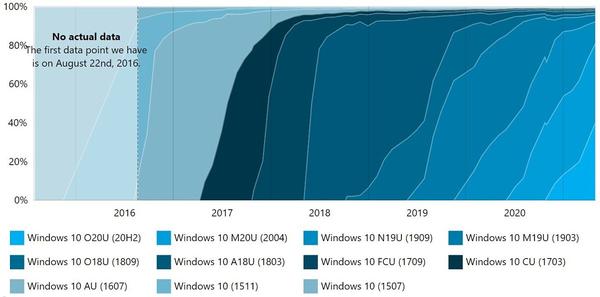Today, AdDuplex released its monthly report on Windows 10 version usage. It’s based on the usage of about 5,000 apps in the Microsoft Store that use AdDuplex SDK v.2 and higher. The data was collected on April 26.
Notably, the newest version of Windows 10 is almost as popular as the version before it. The October 2020 Update jumped by 10% this month, meaning that it’s now on 40.1% of the PCs that were sampled. The May 2020 Update is still ahead at 40.6%.

Still, that means that 80.7% of Windows 10 PCs are on one of the two latest versions. Version 1909, which is still supported for now, is on 11.1% of Windows 10 devices. That means that 8.2% of Windows 10 PCs are running a version of the OS that’s not supported for consumers.
The 3.3% of users still on Windows 10 version 1903 aren’t supported no matter what SKU they’re running. It hasn’t been supported since December. Versions 1809 and 1803 at 1% and 1.4% usage, respectively, are still supported if you’re using Windows 10 Education or Enterprise. Older versions, which are on 1.8% of PCs sampled, could be supported through the Long-Term Servicing Channel.
We can see from the chart above that Windows 10 versions don’t roll out quite as quickly as they used to. This change happened with the fall 2018 update, as can be seen clearly. The November 2018 Update was released, skipping the Release Preview ring of testing. It had to be pulled because some users’ data was getting deleted. Since then, Microsoft revamped its update strategy. It no longer automatically installs updates unless you’re on a version that’s nearing the end of support.
It’s clear that by next month’s AdDuplex report, Windows 10 version 20H2 will be the most popular version of the OS. Of course, by then, we’ll likely be talking about usage of the next version of Windows. That’s version 21H1, and it’s going to be a minor update like 20H2 was. It should arrive some time in May, although Windows Insiders on the Release Preview ring have yet to get their hands on it.
